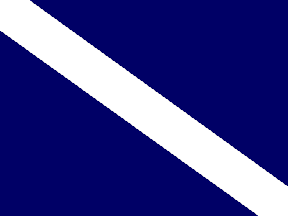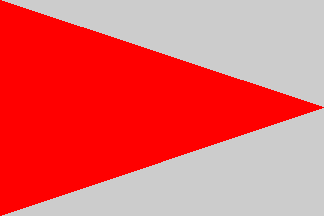
 |
Yachting Flags |
|---|
As indicated by the use of the term "signal" in the enabling legislation, it was never the intention that this flag would replace the standard national ensign as a means of identifying a yacht's nationality, nor did the law authorize it to be used in that fashion. When the secretary of the New York Yacht Club solicited members' ideas for a design in late 1848, he specifically described the flag as a "distinguishing flag to be worn at the masthead," not as an ensign that would have been worn at the stern or gaff. Eight years later, the authoritative Rogers' American Code of Marine Signals (1856), which was approved for official use by the Navy and Treasury departments, stated that "the Yacht Flag is only displayed above the telegraphic numbers of the Yacht Club vessels."
Nevertheless, probably because of its resemblance to the national ensign, the yacht ensign came to be flown in lieu of it as early as 1850. In 1916, Secretary of the Navy Josephus Daniels and Secretary of the Treasury William McAdoo both argued against the the practice of using the yacht flag in this fashion. On February 12 of that year, Daniels wrote to the House Commerce Committee that "in the opinion of the department [of the Navy], all American vessels should fly the American flag, and any other signals and any other flags should be in addition to the national ensign and not in lieu thereof...." McAdoo went further in a letter of February 10, not only stating that "the propriety of permitting this custom to continue--using the so-called yacht ensign as a substitute for the national ensign--may well be questioned," but providing draft legislation criminalizing the display of any flag but the national ensign from the points of hoist normally reserved for the ensign: the flagstaff at the stern or the peak of the gaff of the aftermost mast. Nevertheless, most yachtsmen continued to use the yacht flag in lieu of the national ensign. Some even believed that it was illegal to fly any ensign other than the yacht ensign on a yacht large enough to qualify for the Treasury license.
Eventually the Navy gave in. A 1939 opinion of the Navy Judge Advocate General, approved by the Secretary of the Navy, extended de facto recognition to the use of the yacht ensign as a substitute for the national ensign by allowing Navy ships to return salutes rendered by dipping the yacht ensign and by authorizing members of the Navy to salute the yacht ensign upon boarding or leaving a boat on which it was displayed.
The other perennial issue with the yacht ensign was enforcing the rules on its use. From its first adoption, its purpose was to indicate that a yacht was licensed by the Treasury Department, allowing it to enjoy the exemptions from customs procedures set forth in the law. Vessels below a certain size threshold, which was changed over the years, were not even eligible for such licenses (because they were not subject to the normal customs rules in the first place), yet the yacht ensign was used widely by boats of all size. Many yacht clubs even had (and have) club rules requiring the use of the yacht ensign rather than the national ensign, whether or not a given member held the Treasury license. The issue became moot in 1980 when the new Vessel Documentation Act (Public Law 96-594) did away with both the special yacht license and the accompanying requirement to display the yacht signal. The yacht ensign is now flown as a matter of custom as an alternative to the national ensign by recreational craft sailing in U.S. territorial waters, but should not be displayed in foreign waters. Most yacht ensigns are manufactured in proportions of 2:3 or 3:5, but the traditional dimensions, as shown above, were the same as those for the national ensign, 10:19.
I am indebted to James Liston, attorney-at-law, Houston, Texas, for the historical and legal insights provided to this discussion.
Under sail, a sailboat rigged with a gaff flies the ensign at the peak of the gaff of the aftermost mast. Those without gaffs, such as Marconi-rigged sailboats, traditionally sew the ensign to the leech (aftermost edge) of the mainsail, about two-thirds of the way to the top, putting it at a comparable position to where the gaff would be if there were one. Modern sailboats whose booms are high enough to clear the staff when coming about often fly the ensign at the stern whether under way or not, although traditionalists frown on this.
Power yachts equipped with a mast with a gaff display the ensign at the gaff when under way. Motorboats without such a gaff--today the majority--normally display the ensign at the stern staff, unless doing so would interfere with the activity of the boat, as in the case of a deep sea sport fishing boat. In that case, a halyard is rigged to fly the ensign elsewhere, such as behind the tuna tower.
Vessels under way display the ensign in inland or territorial waters or when passing other vessels on the high seas. It is not normal to keep the ensign flying in international waters if no other vessels are in sight. Ensigns are not flown while racing. And no flag other than the ensign--national or yacht--is ever displayed at the stern flagstaff, the gaff, or the leech of the sail.
| A | B | 2 | U | J | 1 | K | E | 3 | G | H | 6 | I | V | 5 | F | L | 4 |
| D | M | 7 | P | O | 3rd Sub | R | N | 1st Sub | S | T | 0 | C | X | 9 | W | Q | 8 |
| Z | Y | 2nd Sub |
However, the courtesy ensign is not flown on an arriving vessel until it has cleared customs and immigration. Upon arrival, it hoists the so-called "quarantine flag," the solid yellow International Code of Signals Quebec flag. Despite the popular name, this flag does not indicate a vessel under quarantine but rather says "I am free of disease and request free pratique," i.e., approval to land. Once customs, immigration, health, and other formalities are completed, Quebec is hauled down and the courtesy ensign flown until the vessel leaves the host country's territorial waters.
Although there are no United States laws or regulations requiring the display of these flags, even American vessels should fly the Quebec flag until completing arrival formalities. While U.S.Customs is now normally notified of arrival by radio or telephone, the display of the yellow flag indicates to inspectors exactly which boats need to be cleared, which can expedite matters considerably in a crowded marina.

The solid blue "owner absent" flag is flown from the starboard main
spreader to prevent visitors from having to pull a rowboat across the harbor
in order to find out that only the hired crew is aboard to receive them.

The same flag with a white diagonal stripe flown at the starboard spreader
indicates that, although the owner is not aboard, a guest is.
Just in case you are coming across to visit the guest instead of the owner.

A plain white flag at the starboard main spreader says the owner is
at the dinner table. Only flown in daylight hours while not under
way.

A red pennant at the port fore spreader indicates that the crew is at
a meal. Only flown in daylight when not under way.
Sea
Flags
Copyright 2000, 2001 by Joseph McMillan